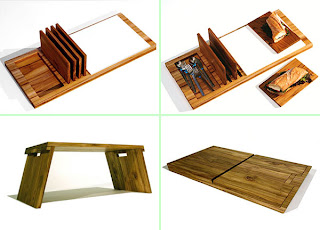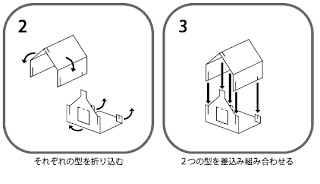idea takes new direction
instead of promoting the rural areas of australia to the folk of the city, i am going to bring these people the rural areas to the city!
i will design an architectural solution which will address the issue of confined living spaces and issues stemming off this such as depression and loneliness and lack of human interaction
the design will be mobile and easily transportable
it will be modular and pre-fabricated in a factory and transported in a flat-pack manner which when assembled slots together without any nails or screws
it can be used by a single person or can slot together with others to be used by a small or large group of people
due to the manner of the design and its modular form, there will be different assembly outcomes depending on what the user wants
users will be taken to anywhere they want away from the city through virtual devices
sound, imagery and touch will help to enhance this experience
exploring modular, stackable and 'slot-together' assembly in design
http://www.chictip.com/
http://ergonomicofficefurnitures.com/cardboard-furniture-design/
http://thedesignhome.com/furniture/1276-pied-de-poule-modular-wall-shelf-system
ryan frank - isabella stool
http://blog.sub-studio.com/2008/08/ryan-frank-isabella-stool/
http://blog.sub-studio.com
'Just Fold It' is a modular room divider designed by Kutarq. Flexible and lightweight, the room divider is very easy to assemble and disassemble. The length of the divider can be adjusted by adding or removing the number of modules. The surface of the divider has perforations which helps to reduce the wind resistance and increases the stability. When not needed, the individual panels fold compact making them convenient to store or transport.
http://thedesignhome.com/furniture/1263-just-fold-it-room-divider-by-kutarq
Tsai Design Studio created this interesting bunk bed as the winning entry to the 2006 36sqm Challenge, a design competition that asked for solutions for large families living in small spaces (36 sq. meters, to be exact). The Nested Bunk Beds were inspired by traditional Russian Matriochka dolls, with five nested beds that can be pulled out for sleeping. The design went from concept to reality after being installed at an AIDS orphanage in Wellington, South Africa.
http://blog.sub-studio.com/2008/03/tsai-design-studio/
http://blog.sub-studio.com/2008/03/domestic/
http://blog.sub-studio.com/2008/02/yuriko-takahashi/
This project won an award from Wallpaper for the Best Shelving System of 2006. I’m not sure how functional it would actually be as a shelving system, but I think it makes for an attractive screen or room divider.
http://blog.sub-studio.com/2008/01/alfredo-haberli/
Shapes from Unto This Last. All of the furniture is produced with a computer-controlled machine, and can be somewhat customized.
http://blog.sub-studio.com/2007/03/unto-this-last/
Two interesting items from Pryor & Williams: the Sandwich Board which is a prep surface and serving tray all in one, and the BIB Tray, which is a multipurpose bed tray/laptop table/coffee table. I like that it is collapsible and easily stored.
Temporaryy small house: for people who take refuge in a gymnasiums
Temporally small bedroom that allow for private and warm space
http://www.atelier-opa.com/suzuki-lab/ds1.html
artek & marimekko
Scandinavian design is huge in Japan right now. That’s why it’s only fitting that Finnish heavyweights artek, famous for their stools, and marimekko, famous for their fabrics, collaborate in Japan for an installation. “Be Honest” will feature an installation using Alvar Aalto ‘s Model No. 60 stool (circa 1933), as well as reinterpretations of his stools by marimekko designers. Taking place at SPIRAL in Tokyo, the show will open this Saturday and run for 2 weeks.
http://www.spoon-tamago.com/2008/09/05/artek-marimekko/
Dolmen Portable Folding Chair
The Dolmen Portable Folding Chair (1000 yen) is the world’s lightest chair, and the first paper chair ever to be commercialized. Weighing just 360 grams (0.8 lbs) and collapsing to the width of a book, it fits right into your bag. It employs a honeycomb structure that can support the weight of just about anyone. I would imagine it would be helpful on camping trips or other outdoor outings. They say it can last a lifetime “if used gently.”
http://www.spoon-tamago.com/2009/09/23/dolmen-portable-folding-chair/
mobile dining
http://www.spoon-tamago.com/2009/07/30/mobile-dining/
BOXINBOX by Keiji Ashizawa
In collaboration with Tanseisha, Keiji Ashizawa recently designed BOXINBOX. Comprised of a sleek metal frame and oak-veneered plywood sliding boxes, the piece is an ultimate exploration into minimalism. Instead of moving on to something new, Ashizawa decided to look back on a previous design done last year, modifying and improving upon it by giving them Russian doll characteristics. The nesting shelves allow for the chest to be transported in a much more economical fashion.You can see Ashizawa’s shelf, along with shelving systems designed by 10 other big names in the Japanese design circle, at the Axis Gallery starting Sept. 27.
http://www.spoon-tamago.com/2011/09/19/boxinbox-by-keiji-ashizawa/
eye-
candy
The “Wide Chair” is essentially one piece of DiBond, part of which is molded into chair form and the other part which folds up to become the arm rest of the chair. “Wide chair” was designed by Aleksi Penttilä, who is part of the Finnish design collective Rehti.
http://blog.sub-studio.com/2007/03/rehti-aleksi-penttila/
Thanks to Filipe Zanardi for sending us an email about his Carpet-Lounge. This has gotten a lot of press already, but I thought it was worth mentioning here. I love the innovation on the traditional carpet as a gathering space. So often when lounging around my living room on my rug – after my elbow or butt has fallen asleep – have I wished for something to lean up against, and voila! Here you go! Instant chair!
http://blog.sub-studio.com/2007/03/filipe-zanardi/
Loyal Loot
Beautiful nesting tables from Loyal Loot. The tables in the Bonnie and Clyde series are made of cold-formed mahogany plywood.
http://blog.sub-studio.com/2007/03/loyal-loot/
id 360
The “Symbol” is an interesting, multi-functional piece of furniture by ID 360 that functions as a chair, a bench, a side table…It’s sort of funny looking with all of its arms but I love that it does lots of things at once.
http://blog.sub-studio.com/2007/03/id-360/
alfredo haberli - namea sideboard
This is an amazing sideboard by Alfredo Haberli. It can be opened up or closed back down depending on what configuration you want for the day. The design is very sleek, with no visible hardware.
http://blog.sub-studio.com/2007/06/alfredo-haberli-nemea-sideboard/
jim hannon-tan
I love the Clampleg by Jim Hannon-Tan. Besides being gorgeous, it allows you to make a table out of any surface. The heights are adjustable so if you have wonky floors like me, you can level your table.
http://blog.sub-studio.com/2007/08/jim-hannon-tan/
nomad space browser prototype-morphine
This gadget is an instant-personal space for people roaming on the street. The flexibility LED screen front of the user shows that all information from urban life. unfortunately I cannot upload this video to the blog but please take the time to look at it!
http://vimeo.com/4046714
mobile cutting table
recht's 'cutting table no. 1' is a result of his constant travel in which he is continuously setting-up guerilla studios
wherever he is, however always lacking a good clean surface in which to work. constructed from corrugated cardboard,
the biodegradable furniture piece is lightweight and can be disassembled at the end of the day to make room for other activities.
mobile cutting table
recht's 'cutting table no. 1' is a result of his constant travel in which he is continuously setting-up guerilla studios
wherever he is, however always lacking a good clean surface in which to work. constructed from corrugated cardboard,
the biodegradable furniture piece is lightweight and can be disassembled at the end of the day to make room for other activities.
http://designboom.com/weblog/section.php?SECTION_PK=izkyhztndddtqdhq&start=1080&num_record_tot=3082


























































































































